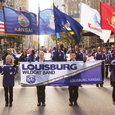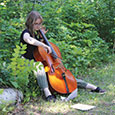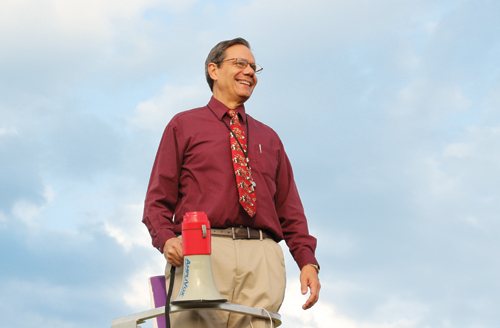
John Cisetti views his ensembles in Louisburg, Kansas as a way to promote not just musicianship but citizenship. He knows that seasons come and go, but the lessons of teamwork and service to the community linger. According to this veteran of 37 years teaching music in the same district, “We talk a great deal about using our talents to serve our community with our musical skills. What I want them to take with them is the skill of working together with people who are all doing something different with a common purpose.” Cisetti teaches 400 students daily in grades 5-12 in three different buildings, and his groups give more than 50 performances during the year. He was a semifinalist for the 2001 Kansas Teacher of the Year. He earned a Bachelor of Music Education, a Master of Arts, and an Educational Specialist degree from the University of Missouri-Kansas City Conservatory of Music and School of Education. His groups consistently receive first-division ratings.
After nearly four decades of teaching, what have you learned about running rehearsals?
I am a better teacher than last year or ten years ago. By next year I will be better than I am now. I am always learning new things. I learned quickly the importance of staying organized and teaching from bell to bell. I put up a whole lesson plan on my projector listing the warmup, how we are going to check intonation, and the music we will play. When students enter the room it is right in front of them. I just step up on the box and go.
I have improved at planning rehearsals over a two-month period before festival. Technology has also made my teaching more efficient. I can easily play a recorded musical example to show what the music should sound like. I use a document camera to show the score. In choir all of the parts are in front of you. In band, the second flute does not know what the third trumpets are doing. I can put the score up on the projector and everyone can see the relationships in the music.
This past year, all of our students received Chromebooks. I doubted that we would use them much in the band room but discovered that I can write an eight-measure sightreading piece quickly without having to distribute music. In the morning, students check their email and open the sightreading piece. I can create a brand new sightreading piece daily, and it is all done electronically.
One unusual feature of your program is a summer camp devoted to concert band.
Our concert band camp runs for a week in June with different activities for various grade levels. We hold an exploratory class for the incoming 5th graders that covers many instruments for an hour each. Students learn how to put the instrument together and produce a tone. This gives us a jump on instrument selection, and I get to know the beginners better. This is especially valuable leading into the next school year.
In the summer, I teach sixth graders three hours a day for a week, seventh graders the second week, and seventh through twelfth graders the third week. During that time we play concert band music and other areas that might come up later in the summer. We sometimes go out to the parking lot to learn a marching fundamental.
The highlight of the summer concert band class for older students is second instrument class. For students who always wanted to play clarinet, saxophone, or snare drum, this is their chance. We spend 45 minutes a day with the beginning books, and students get to try a different instrument. Sometimes this class has a practical purpose, such as helping the flutist who want to play in jazz band begin to learn saxophone. Sometimes student ends up moving to tuba or some other needed instrument next year. Some students simply enjoy trying a different instrument every summer.
You write your own drill for marching band. How does this help your teaching?
I am spread thin teaching 5th grade through high school. I do not have time for extra marching rehearsals. Students also have sports and other activities, so I cannot ask them to give much more time either. I have to be efficient with rehearsals. When the bell rings, we work the whole time.
I write all my own drill and buy music off the shelf. When developing the drill, I am putting faces with the dots. I know each student and what I can expect from them. I also think as I write about how to teach the drill in the 90 minutes I have every other day.
I construct drills that facilitate quick learning and use all the tools at my disposal. There is no reason to have students stand three inches off the yard line; have them stand on the yard line. If someone else wrote the drill, I would have to learn it before I could teach it. Instead, I know it drill inside and out.
With difficult shapes and curves (diagonals can be difficult to get right) we may go out on the practice field and paint it. “Get to the orange line and find your spot there.” Amazingly it works. During the performance the line is not there, but by then it does not matter. Having that option available for blocking out and teaching sets students up for success.
I enjoy writing the drill, but it is hard work. There are times when it is midnight, and I am pulling my hair out. It is like working a puzzle. When I first started there was no computer drill software. I had a light box, drafting tools, and graph paper, and I did everything by hand.
How do you organize marching band camp?
During the last few weeks of school, we hand out music and start to learn next year’s show. Marching camp consists of two eight-hour days and three more evenings. We spend time working inside as a group and in sectionals and also include practice parade marching. Every year we lead the local Labor Day parade. We learn our pregame and half of the first drill for our halftime show during camp. At the end of the week we give a performance for the parents.
What is the Electric Light Band Show?
Every year we present our marching show on a Saturday night for a packed crowd at the stadium. We play it once with the overhead lights on, and then again with the lights off. The students decorate themselves with Christmas lights and glow sticks, and we march the show in the dark. This event is quite popular and frequently includes fireworks.
I wish I could take credit for this idea, but we all borrow from other directors. I do not hold many rehearsals outside of the school day, but did schedule one evening rehearsal each year before a festival. I invited the parents to watch us, so it became an informal performance. I had heard of the electric light idea but knew it could be dangerous and impractical to turn off the lights during a football game. I tried it one year during the evening rehearsal, and everybody loved it.
I tell my kids to figure out how to light themselves up in a way that does not damage the uniform or instrument or interfere the performance. They come up with all kinds of crazy ideas. It is so much fun watching students decorate themselves in band room an hour before the performance.
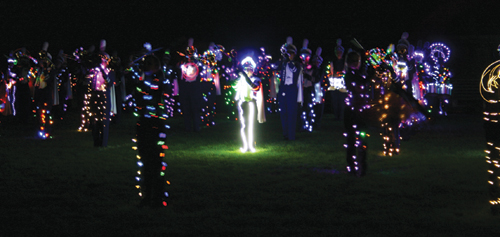
Your group is also known for incorporating a giant flag into its marching performances. How did that begin?
One year we planned a patriotic show for a field competition. I decided to end it with the Battle Hymn of the Republic and open up a big flag on the field. We discovered that you can buy 20′ x30′ flag, the largest off-the-shelf size available. It cost $600 at the time, and a community donor came up with the money. I wanted the flag’s appearance to be a surprise at the end of the show. We have it folded like an accordion lengthwise and then again in the opposite direction. Folding it this way makes it possible to open the flag suddenly by pulling the four corners. I built a wooden box at home to hold it in place when folded. Everybody loved the flag so much at the show that it became a tradition at every game and parade. We have used it to play the National Anthem at baseball games for the Royals, Cardinals, and Nationals.
On the Friday after September 11, 2001, we climbed up to our school roof and draped the flag over the side of the building. Everyone passing on the highway could see it. It was a real inspiration. The flag became dirty in the process, and we had a football game the next week. I took it home, spread it out on an island in our kitchen. I scrubbed it a section at a time. I happened to have a television on and saw the President addressing Congress. It was a poignant moment polishing the stars of the flag while the President was speaking to Congress about the attacks.
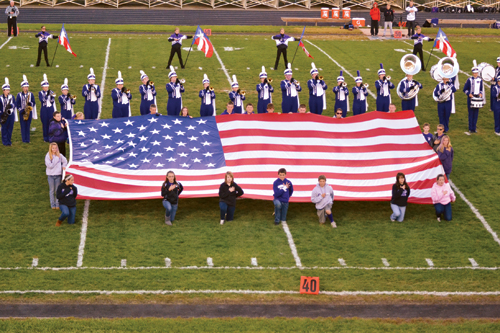
Your groups take a big trip every four years. How do you raise the money?
We have held an annual garage sale for 26 years. The event has grown dramatically and now includes a silent auction. The bands and choirs also perform. I like this approach better than selling products door to door. The items are all donated by families in the band and except for a few expenses and promotion, the garage sale is almost pure profit. We start setting up on Tuesday afternoon and begin selling on Thursday evening. By 4:30 on Saturday afternoon, the gym is empty again and the floor swept. The Salvation Army picks up most of the surplus items. We raise $25,000 from this, and it is one of our only fundraisers. The garage sale has the added benefit of bringing everyone involved in band together. Young students, older students, and parents all work together on this, and it builds camaraderie.
I try to limit fundraising; that is not why we are here. The school pays for the regular expenses of the program like music and instruments. The sole purpose of our fundraising is to pay for our big trip. Every family has an account that accumulates money over four years to cover the travel cost.
What have been the most memorable experiences from your travels with the band?
We want every student in the high school program to take a trip at least once. We have gone to the Indy 500 parade, the National Independence Day Parade in Washington, and the Cotton Bowl.
Our most recent trip was to New York for the Veterans Day Parade. When I take students on a trip, the purpose is education. We have fun, but it is not a vacation. For the New York trip, I assigned every student to find a veteran in their family or neighborhood and interview them or people who knew them. I worked with the English department to develop a series of small assignments, and students ended up with a descriptive paragraph that included an interesting anecdote for each veteran, along with a picture. We produced a book with all of the pictures and short essays. We also made buttons with pictures of the veterans, and students wore them on their uniforms during the parade. You could walk up to any students and ask about their veterans. Before the parade, I told the students that none of us are veterans. We have been invited to be part of this parade, and have a duty to represent people who maybe never got a parade. The band marched with pride.
How did you end up conducting at Sousa’s grave with his baton?
After reading books about Sousa and seeing pictures of his monument in Washington, D.C., I had always hoped to visit the monument; the year we traveled to Washington for the Independence Day Parade was my opportunity. I contacted the Congressional Cemetery and asked to visit his grave. They were pretty excited at the cemetery, and they contacted the Sousa family. When the band arrived to perform, cemetery officials pulled out Sousa’s baton, and I conducted Taps over his grave using the baton. My assistant then conducted a Sousa march with the baton. That was pretty cool.
adj.jpg)
What are some of the musical highlights of your career?
There are two songs that have been written in my honor. One is Fantasy Suite on Hot Cross Buns by Barbara York. The other one is Robert E. Foster Jr.’s Festival Tribute. The Hot Cross Buns was written to celebrate my 30th year of teaching. I love Hot Cross Buns; it is my favorite song. When you teach beginning band, you start with just a few notes. To students it is just sound. When students play Hot Cross Buns, all of a sudden light bulbs come on as they realize that they are making music with these sounds. The day they play Hot Cross Buns is the first day they play music. I thought it would be cool to have a legitimate high school-level piece based on this song. Barbara wrote a four-movement suite. that starts by bringing the 5th graders out on stage to play the opening theme and then the high schoolers take over and play all kinds of development. For the second piece, Rob Foster used the rhythm of my name and wrote the piece based on that motif.
What was the most poignant moment in your teaching career?
Once we were preparing a piece for seventh-grade music festival that included a brief trombone solo. The young player struggled mightily with that two-measure solo. Sometimes it would come out, but it was hit and miss. I stuck with him.
When we played at the contest, I gave him the cue and he nailed it. I flashed him a big smile, and he smiled back. I later learned that this student was facing serious problems at home. Life was pretty grueling for him at the time, but that one moment of sunshine made all of the difference in the world. We never know when something we do or say in class might change the lives of our students. As teachers, we touch the future.
* * *
John Cisetti’s ensembles include fifth-grade beginning band, which meets daily as one class of 90 students, and separate bands for sixth, seventh, and eighth grade and the high school. In addition, he teaches seventh- and eighth-grade combined jazz band in the fall semester and high school jazz band in the spring semester. The high school jazz band is also the basketball band, giving students the chance to play some more sophisticated music for sporting events. Says Cisetti, “The high school is on an A/B block. I was on the schedule committee and made sure that all students could take music and other activities.”
